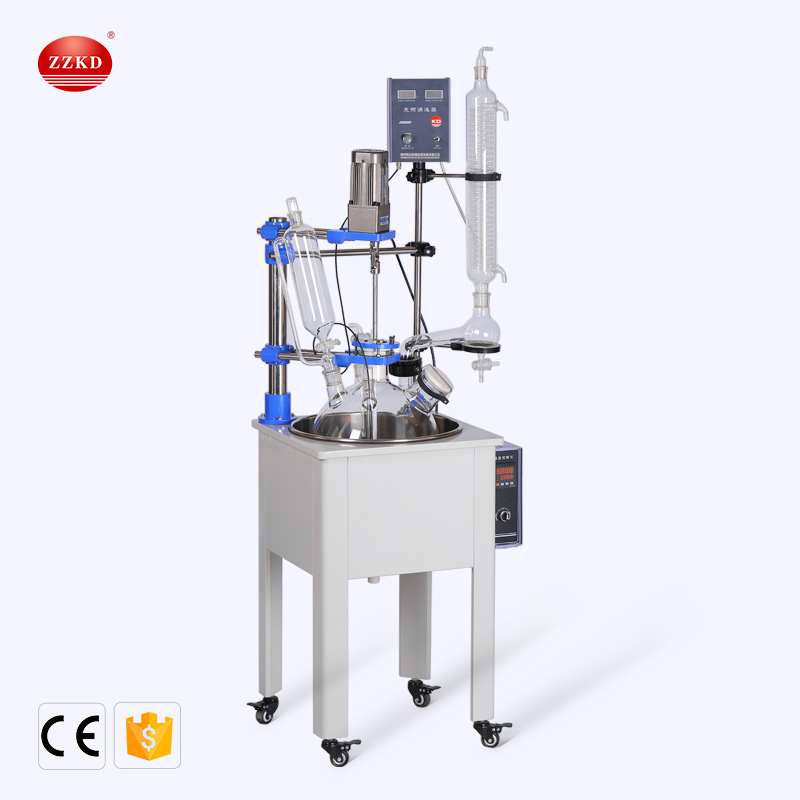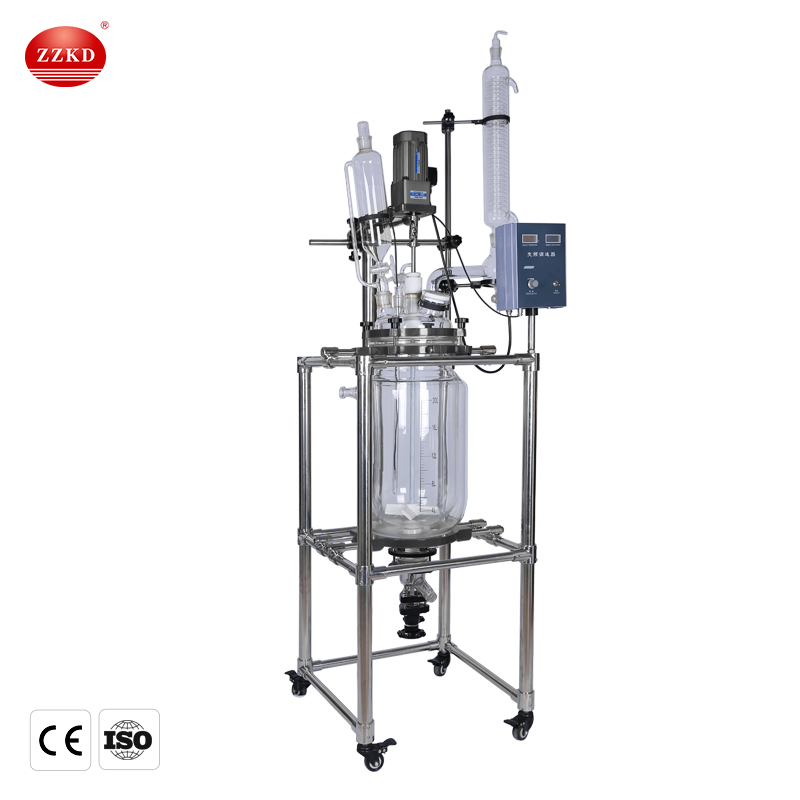20l glass lab reactor manufacturer
The double-layer glass reactor is an ideal equipment for modern chemical small samples, medium-scale experiments, biopharmaceuticals and new material synthesis. The glass reaction kettle injects a constant temperature (high temperature or low temperature) hot melt medium or cooling medium through the interlayer of the double-layer reaction kettle, and heats or cools the materials in the reaction kettle at a constant temperature. The 100l glass reactor kettle can provide stirring. Let's take a look at the specific features of the double-layer glass reactor.
The specific characteristics of double-layer glass reactor:
1. Frequency conversion speed regulation, AC induction motor. Constant speed, no brush, no spark, safe and stable, can work continuously.
2. The whole set of glass instruments is made of GG17 borosilicate glass with good chemical and physical properties.
3. Hot oil is introduced into the interface between glass layers for circulation, which can be used for heating reaction, and freezing liquid is introduced into low temperature reaction.
4. It can react at room temperature, and the reflected heat can be quickly taken away by running water.
5. The discharge port is provided with a flange port and a PTFE valve. There are no dead spots in the container. It is removable for easy discharge of solid materials.
6. Four-port reactor cover, large port design is easy to clean, and standard port sockets can be selected to assemble reflux and distillation synthesis devices.

20L single-layer glass reactor
The glass reactor uses a constant temperature oil bath pot or a low-temperature circulating pump to cyclically heat and cool the reactants through the interlayer of the reactor, so that the temperature control of the reactants in the reactor reaches a high level, which is very important for the efficiency and quality of experiments or production. There is a significant improvement. All are produced with high borosilicate materials, and after the glass parts are processed, the glass parts of the reactor are heated to a temperature lower than the glass transition temperature, and heat preservation is carried out to remove the temperature gradient of each part of the glass parts and make the stress Relaxation, the stress in the glass part is eliminated, the appearance of the glass part will be more smooth and beautiful, and the lifespan will be significantly improved, and it can withstand high temperature of 300 ℃ and low temperature of -80 ℃ without breaking.
Under the set constant temperature, in the sealed glass reactor, the glass reactor can perform stirring reaction under normal pressure or negative pressure according to the requirements of use, and can perform reflux and distillation of the reaction solution. It is a modern fine chemical, biopharmaceutical Ideal pilot and production equipment for synthesizing new materials. The dual-window digital display shows the speed and temperature measurement values, with high temperature measurement accuracy and small error, which effectively improves work efficiency. The overall stainless steel column mobile frame structure, five reaction kettle covers, with a full set of glass for reflux, liquid addition, temperature measurement, etc. The production must be processed, tested and tested in strict accordance with the corresponding standards. According to different production processes, operating conditions, etc., the design structure and parameters of the reactor are different, that is, the structure of the reactor is different, and it belongs to non-standard container equipment.

20L double-layer glass reactor
In the single-layer and double-layer design of the glass reactor, the reaction materials should also be considered. The requirements for the reaction materials in the glass reactor reaction are as follows.
Requirements for glass reactor reaction materials:
1. Compatible or incompatible liquids
The mixing of liquids is easily achieved by stirring or mechanical mixing, and the heat transfer of the reaction mixture is carried out by convection.
2. Heterogeneous mixing of liquid and solid reactants of appropriate particle size
In this case it is not possible to mix these materials completely with the aid of a mixer. As soon as the mixing force disappears, the bulk material will precipitate to the bottom of the kettle to form a non-conductive material layer and the following phenomena will occur: the solid reactant is carbonized, the color of the mixture becomes darker, the carbonized material is wasted, heat energy and time are wasted, polymerization The reaction is not uniform, the polymer composition is not uniform, and the ecological environment is affected due to the waste of materials and energy. In order to avoid these problems, the reaction materials can be added multiple times in two steps:
1. In one step, add the liquid reaction material to the reaction kettle and heat the medium to a temperature slightly higher than the reaction temperature or the melting point of the solid reactant.
2. Slowly add solid reactants to the glass reactor under constant stirring to allow it to react or dissolve continuously to avoid precipitation. However, this speed cannot be guaranteed, and sometimes precipitation and coking occur. And it takes a long time to complete the reaction.
The above is the 20l glass lab reactor. If you have needs, you can contact Zhengzhou Keda Machinery Equipment Co., Ltd. For decades, Zhengzhou Keda Machinery Equipment Co., Ltd. has been committed to the production and manufacture of laboratory instruments and pipe fittings.
If you want to know about our products, or want to buy our instruments, please feel free to contact us, we will be happy to help you.


